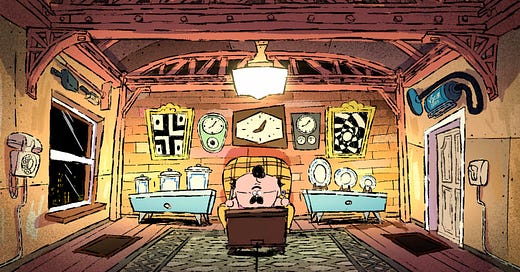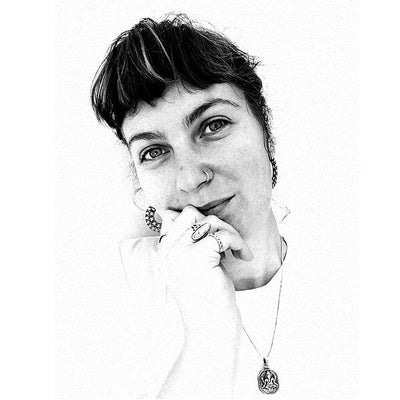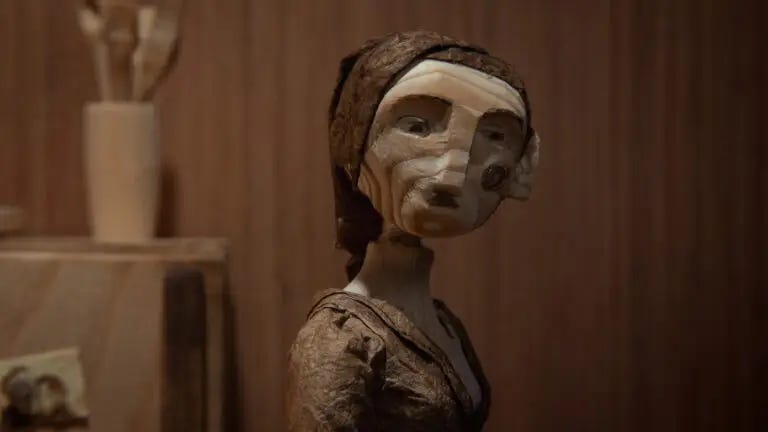Magritte 2025 - 'En Mille Pétales' and 'Muscle Masqué' Directors Talk About Their Nominated Short Films
Louise Bongartz (En Mille Pétales) and Nicolas Gemoets (Muscle Masqué dans: Ferraille Pagaille) dive into the making of these Belgian animated gems
Award season is all over the place. For a long time, I personally didn’t care much about it, most of the time due to lack of time and interest in those self-congratulatory ceremonies that, especially in Belgium, showed — to me — little interest in animation.
But as I dove deeper and deeper into the Belgian audiovisual landscape, my interest grew. Today, with a better understanding on how it works, and a regained interest in Awards season both on a national and international level, I’m happy to take part in it and shine a light on the talents nominated for French-Speaking Belgian Awards Ceremony, the Magritte du Cinéma.
Four Animated gems, in the words of their creators
The Animated Short Film Award — which is the only animation-focused category of the ceremony — will honor a short film from this year’s four nominated films:
‘En mille pétales’ by Louise Bongartz, produced by Camera Etc
‘Les oiseaux’ by Christel Hortz, produced by Camera Etc
‘Muscle Masqué dans : ferraille pagaille’ (Muscle Man in: Metal Mayhem) by Nicolas Gemoets, produced by Atelier de Production de la Cambre
‘Tête en l’air’ by Rémi Durin, produced by La Boîte,… Productions
To present their work, I asked them five questions each. This week, let’s dive into the making of ‘En Mille pétales’ with Louise Bongartz and Muscle Man in: Metal Mayhem with Nicolas Gemoets. Enjoy!
“Wood can hide the trials of time” : Five questions for ‘En mille pétales’ Director Louise Bongartz
The Animation Belgian: What inspired you to tell this story?
Louise Bongartz: Strangely, it was the raw material of wood that initiated this project: its texture, its veins, its irregularities...
I was directing my graduation film at BAU College of Arts & Design in Barcelona. There were several of us who wanted to work on this material in stop-motion, so we came together around the “HEXED” project. [Editor’s note: a stop-motion short released in 2021 by Louise Bongartz, Forest Gamble and Francisco Martins Fontes] For my part, I was responsible for the puppet. It was while sculpting his arm that a knot appeared to me and I said to myself: “It was not initially visible in the piece of wood chosen but, in the depth of the material, this knot revealed itself.”
Immediately, this discovery awakened something in me.
Around me, I was able to observe and meet intelligent and strong women, inhabited by a great force of life who did not see themselves consumed and extinguished out of love or at least for the idea they had of it. And these incredible women, I saw them become shadows of themselves.
And so, this knot in the wood as a mark of time and trials, this mark which is revealed by sculpting the material, well it gave me a sort of impetus to tackle an intimate and serious subject: that of violence within the couple, both physical and psychological violence. Through this short film, I wanted to stay focused on the heroine's "self", her vision and her feelings within this problematic romantic relationship.
And even if this theme is harsh and brutal, I wanted to consider it in a muted way, as diffuse and murky through my animation work. A bit like this violence unfortunately hidden in today’s society. I deliberately slipped subtle metaphors into my film in order to make it open to multiple interpretations, depending on each person's feelings and background.
It is a serious subject, certainly more and more people are speaking out but unfortunately, not yet enough in my opinion, hence the need to talk about it. I would like my film to be able to initiate conversations, open discussion, bring out words to evoke the discomfort of violence against women.
How did the film evolve between your first pitch and the final rendering?
To answer this question, I went back into my production file.
The process is so long that it is sometimes difficult to express. For “En mille pétales”, I stayed quite close to my first version in fact. When I review my first drafts or the storyboard, it’s quite telling.
However, the project has evolved on other points.
First of all, Bastien Martin, my producer at Caméra Etc, allowed me to affirm some of my choices. I wanted the film to remain fairly open to interpretation while leaving some clues for the audience, but sometimes I was too evasive. My producer therefore invited me to clarify the edge of my thoughts.
Then, when we started creating the sets, I was lucky enough to be supported by Clémence Rogge and Francisco Martins Fontes who together created this magnificent set. I am not always very creative when it comes to objects, furniture or buildings, but Clémence and Francisco knew how to bring this creative touch to create an intimate place and tell the story through this decor. Because the objects also already tell my character.
Their sense of detail and precision made this apartment an ideal setting for puppetry.
Tom Gineyts put his talent and patience at the service of the lights which he made authentic to our space needs. These lights bring a special dimension to truly liven up the set. While making it as easy as possible for us to access the sets and the puppet, he managed to enhance the settings and atmosphere of the film.
Then, each of the post-production stages were key stages since I was able to rely on the know-how of generous and competent people such as Marika Piedboeuf (Editing), Laura Perera San Martin (calibration), Quentin Lachapèle (Music ), Charles De Ville (Sound Editing), Aline Gavroy (Mixing)… Each of them took ‘En mille pétales’ even a little further.
In the end, the film remained quite faithful to my very first pitch but at the same time it is very far from it! It's the best version of what the project initially was, in the back of my mind. And I greatly thank everyone who helped make this dream a reality.
What drove you to this particular animation technique?
I feel this need to work with the raw material and what it has to offer, due to its particularities. And I’m also interested in adapting myself to these constraints. It’s an exchange that I find very interesting in the creative process. This material also took me further, to somewhere else that I couldn’t immediately imagine.
What were the biggest challenges during production?
The biggest challenges of the film were creating and animating the insects and petals.
The insects were 3 by 2 cm and given their number, the animation was quite long and repetitive.
The petals had three different scales, the largest had to be 4cm and the smallest 3mm. For the manufacture, storage and animation of the smallest petals, we had to be patient! Fortunately, my colleagues on set, Francisco Martins Fontes and Siona Vidakovic, were meticulous and very patient in their animation.
What strikes you the most when watching this film again today?
I am quite strict with myself, it is therefore impossible for me to re-watch something I have created without seeing its imperfections.
So when I'm in the theater, I don't really watch the film, but I listen to the reactions of the audience. And it’s a very strong feeling to hear an entire room react to certain moments of my film. And these reactions, well, they make me forget the imperfections and comfort me in that we succeeded in making this puppet come alive, in making it the bearer of a strong and current message and that touches me enormously.
Find more about the film here.
“I fell in love with this not-so-super hero” : Five questions for ‘Muscle Man in: Metal Mayhem’ Director Nicolas Gemoets
The Animation Belgian: What inspired you to tell this story?
Nicolas Gemoets: In 2022, I watched a lot of documentaries, one atop the other. In this process, I came across a doctor who talked about obsessive-compulsive disorders and I discovered to what extent these disorders can take painful or even extremely serious forms. The subject of mental health after Covid was already obvious to me and I decide to take up the subject if the opportunity was to arise.
It was also the beginning of the famous “superhero fatigue” that Marvel had initiated with its kiloton of indigestible films representing desperately “super” characters. The combination of the two worlds happened a little by chance: I was drawing a little chubby character, small glasses, big mustache, and I actually fell in love with the character immediately. I knew that he would be the vector of a superhero film whose protagonist is not so super but human.
How did the film evolve between your first pitch and the final rendering?
Initially the film was supposed to be two minutes long. It was supposed to be a very short little joke in which Muscle Man changes into a superhero to go and save the city from a giant robot. But because of his OCD, he cannot leave his apartment. The city ends up exploding off-camera. Once the scene was done I immediately wanted to do more. My little character had just come to life in front of me and I wanted to know what was going to happen next. From there I didn't really know what was going to happen to him. I discovered his new adventures almost week after week. A bit like an old soap opera.
What drove you to this particular animation technique?
This was my student film, and I knew I would probably be short on time since like many other students, we usually work on our films alone. I favored an animation technique that I mastered well enough to allow me to save time. I used a very thick line which allows me to be less precise in the drawings while retaining a certain quality of animation. There is also a lot of tinkering, copy-pasting, and editing tricks to shorten the production time of the film. All of this helped me tremendously in order to finish the film before the end of the school year.

What were the biggest challenges during production?
The biggest challenge was surely in the continuity of the scenario. As I said, I wasn't able to find out the end of the film until much later. I had already animated almost half of the film without really knowing where I was going to end up. At one point I was blocked by the first stones that I had already laid previously. We had to cut out certain scenes that were sometimes completely finished. Fortunately the teachers at La Cambre, my friends and my family were there to offer me another reading of the story that I would never have been able to see without them. That’s what really unblocked me.
What strikes you the most when watching this film again today?
For me, watching this film is seeing again the culmination of total creative freedom. In my head it's a mess: my ideas are constantly jostling and I have a lot of trouble making sense of them when I try to express them. Here, as if by magic, I managed to exorcise all of that and package it all into ordered content, with a beginning, a middle and an end. Each scene was for me a shot of pure freedom that allowed me to express my desires on a day-to-day basis.
And to know that the film resonates with others is a huge surprise that I am extremely proud of.
More info on the film here.
Thank you for reading!
Next week, we’ll talk with the two other nominated directors, Christel Hortz and Rémi Durin.
The Magritte Awards are held on Friday, February 22. More info here.
In the meantime, have a great animated weekend
Kevin










